
Nigeria Zero Hunger/IITA Policy Brief No. 3: Nigeria Zero Hunger Strategic Review – Nutritional Status of Children under the Age of 5 in Ogun State, Nigeria
*Corresponding Author(s):
Iheanacho OkikeInternational Institute Of Tropical Agriculture Iita, PMB 5320, Ibadan, Oyo State, Nigeria
Email:I.OKIKE@CGIAR.ORG
Background
The “2030 Agenda for Sustainable Development” (also known as Sustainable Development Goals - SDGs), has 17 goals [1], to which the Federal Republic of Nigeria committed to achieving in September 2015. Among the SDGs, Nigeria prioritized SDG 2, the so-called Zero Hunger goal, calling on member states to “End hunger, achieve food security and improved nutrition, and promote sustainable agriculture”. The Nigeria Zero Hunger Strategic Review was established and it sought to apply an open and consultative process to articulate what Nigeria must do to achieve SDG2 by 2030. That process was led by His Excellency, Chief Olusegun Obasanjo, and former President of the Federal Republic of Nigeria. The Nigeria Zero Hunger Strategic Review determined to conduct a baseline survey to establish the true situation at the start of the review to enable tracking of the progress. The International Institute of Tropical Agriculture (IITA) was charged with the responsibility to lead baseline surveys in partnership with the Farm & Infrastructure Foundation (FIF) in five states – Benue, Ebonyi, Kebbi, Ogun, and Sokoto aiming to capture the nutrition outcomes along agricultural intensification and market access gradients across four of Nigeria’s six major agro ecological zones. A design workshop by stakeholders was held and followed by field activities for data collection were conducted with full support of governments in the states, the National Bureau of Statistics (NBS), UNICEF and the World Food Programme (WFP). The preliminary findings of the surveys were reviewed and validated by the representatives of the five states and other stakeholders at IITA, Ibadan in 2017. This policy brief summarizes findings for key parameters for Ogun state especially on the issues of poverty, hunger, nutrition & health care, and other nutritional outcomes in children under 5 years of age. The statistical comparison summarized are between Ogun state and the average for all five surveyed states. It ends with policy recommendation to attain the goals of SDG2.
Household Poverty And Hunger
3.6% of households in Ogun state lives below US$1.9 per person per day compared to an average of 28.9% of households in all five states. On hunger, 10.3% of households experience hunger broken down to 7.0% at moderate level and 3.3% as severe compared to an average of 27.7% for the five states (with 17.1% and 10.6% of households in the surveyed states experiencing hunger, moderately and severely respectively). The combined effects of poverty and hunger on households led to gloomier picture for Ogun households where 6.1% are poor and suffering severe hunger (Figure 1) when compared to an average of 45.4% of households in other states (Figure 2). Ogun state had the lowest numbers of poor and hungry households which is good progress. However, the goal remains zero hunger for all households by 2030.
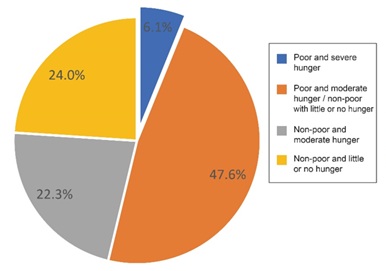 Figure 1: Effect of combining hunger and poverty (% of households) in Ogun state, Nigeria.
Figure 1: Effect of combining hunger and poverty (% of households) in Ogun state, Nigeria.
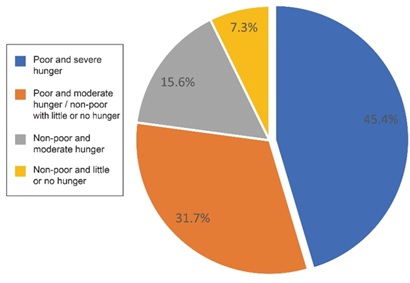 Figure 2: Effect of combining hunger and poverty (% of households) in Benue, Ebonyi, Kebbi, Ogun and Sokoto states, Nigeria.
Figure 2: Effect of combining hunger and poverty (% of households) in Benue, Ebonyi, Kebbi, Ogun and Sokoto states, Nigeria.
Child Breastfeeding And Complementary Feeding
Child nutrition was studied in terms of infant and young child feeding practices and complementary feed offered to infant (during weaning). Breastfeeding practices had similar profiles and no cause for concern in Ogun state compared to profiles for the rest of Nigeria presented in Food and Nutrition Technical Assistance (FANTA2) in WHO [2] (Figure 3). A large majority of mothers and caregivers offered cereal supplemented with other proteins compared to elsewhere. In clear positive deviance, the lowest proportion of mothers gave their weaned infant unfortified local cereal-usually of doubtful dietary quality (Figure 4). They were also ahead of the overall average in offering infant formulae. When these feeding practices are laid alongside the results of analysis of child malnutrition, the outcome was not as outstanding as the practice. This calls into question the quality of the supplements. Even though the need for fortification of complementary feeds appears to be well known among mothers and caregivers in Ogun state, there appears to be a gap in stressing the aligning need for quality supplements.
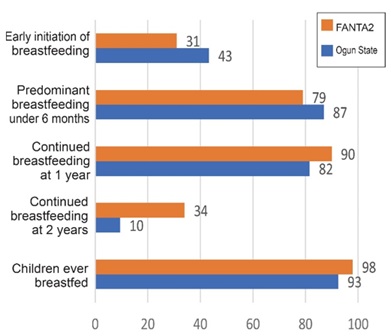 Figure 3: Child breastfeeding practices in Ebonyi State, Nigeria compared to FANTA2.
Figure 3: Child breastfeeding practices in Ebonyi State, Nigeria compared to FANTA2.
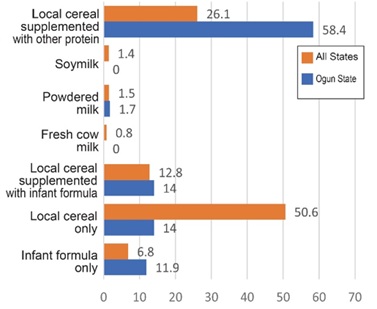 Figure 4: Proportion of mothers (%) offering various types of complementary feed to their infants in Ebonyi state compared to other surveyed states.
Figure 4: Proportion of mothers (%) offering various types of complementary feed to their infants in Ebonyi state compared to other surveyed states.
Child Health Care And Nutritional Status
Mothers in Ogun state were ahead of the surveyed states in starting child immunization (71.9% compared to 65%) but level with others in terms of proportion completing child immunization (60.6% compared to 61.2%). This meant that nearly 40% of children under five were not presented for full immunization and remain vulnerable to preventable diseases. They had fewer cases of recumbency and diarrhoea compared to the other states surveyed (Figure 5). However, there were higher incidences of fever, cough, and visible signs of ringworms. Compared to the commendable performance of mothers in breastfeeding and complementary feeding, there is a slack in child health care that should be addressed among other needs.
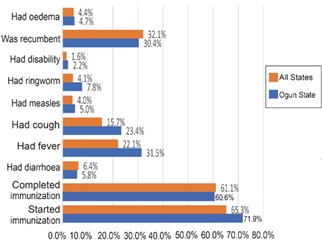 Figure 5: An overview of proportion of child health/care events in Ogun state compared to the average of all surveyed states, Nigeria.
Figure 5: An overview of proportion of child health/care events in Ogun state compared to the average of all surveyed states, Nigeria.
Bringing it all together and analyzing the combined and measurable impacts of poverty, hunger, nutrition and health on the well-being of children and infants, Ogun state falls behind both the global average for developing countries and the average for the studied states for Weight-for-Age Z-scores (WAZ) and Height-for-Age Z-scores (HAZ) which measure short-term and longer-term nutritional status of children respectively. For example, while global average for underweight was 8.9% in 2015 [3], figure 6 shows that 16.4% of the children in Ogun state were underweight of which 5.3% were severely underweight. Of great concern is the coexistence of underweight and overweight as 11.1% of the children were overweight with 8.6% of them obese.
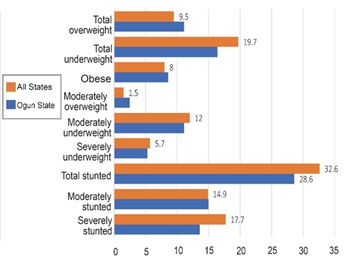 Figure 6: Prevalence of malnutrition (%) among children under 5 in Ogun state compared to other surveyed states.
Figure 6: Prevalence of malnutrition (%) among children under 5 in Ogun state compared to other surveyed states.
For stunting, the global average for developing countries in 2015 [3], was 25% compare to 28.6% stunting in Ogun state out of which 13.6% were severely stunted. Policy makers in Ogun state must be alarmed by these figures and determined to take every possible measure to address them.
Policy
The policy analysis component of the baseline study investigated the state for the presence or absence of programs, projects, and other initiatives of the public authorities required to create and sustain an enabling policy environment for achieving Zero Hunger targets by 2030 in the state. The results are detailed in the main report. Hereunder is a summary of the key findings:
Policy articulation
Since its creation in 1976, the State has sought to achieve self-sufficiency in food production, providing raw materials for agro-based industries, generating employment opportunities as the main thrust of agricultural policy, through a series of operating policy documents: Ogun State Agricultural Policy Document (April, 1989); Ogun State Cash Crop policy (2007); and lately Agricultural Sector Implementation Plan (SIP) (2016-2018). The SIP features a “performance-based extension service” and land development for easy access as part of the major policy thrusts for maximum exploitation of the fertile land that is suitable for cultivation of many crops notably rice, cassava, cocoa, oil palm, cotton, and kola, and fisheries development. In 2008, a DFID-supported rice policy was produced which suffered a major delay after the meeting of major stakeholders in the rice industry, and the stakeholders protested about the delay and domination of the process by government officials.
The review of policies revealed the need to produce a concrete policy document for agricultural and food security with popular participation by stakeholders in the articulation of policy documents. There is a lack of philosophical context on which to anchor the contents of the policy documents for food security in the state. Recognizing the role of infrastructure as the backbone in agricultural development; it is recommended a systematic provision of rural infrastructure in the policy documents of the state, consistent with the provision for agriculture or food security in the Constitution. In many instances, no data was available to access the potency of policy instruments in respect of certain targets required for meeting the SDG2, implying that little or nothing is going on in these States relating to these aspects. The need arises for Ogun state to conduct a comprehensive review of its food and nutrition security policy, in order to explore opportunities for meeting the Zero Hunger targets and to incorporate the tenets of food as a human right in the new policy, both of which are in consonance with global trends.
Policy implementation
The several agricultural programs of the State originated from the Federal government in or in partnership with external bodies-United Nation Environment Programme (i.e., BACOSA cocoa program), FGN, (fertilizer program, Anchor Growers Policy; FADAMA III (maize and tomato production), IFAD-assisted Climate Change Program, DFID (PrOPCom) The complaints of stakeholders centered around the inadequacy of land clearing operations and untimely supply of farm inputs; specifically, that the support of IFAD in clearing 20 ha of land/LGA in 3 LGAs was not enough for the scope of production and innovations that exist in the State for improved seedlings and other innovations to boost productivity.. Besides, in spite of its potential, the rice industry is faced with several challenges, inadequate access to farmland, high cost of land clearing, and non-availability of farm inputs especially seeds and fertilizers.
In addition to policy articulation, other problems and challenges occur at the stage of implementation. Such constraints are usually shortage of funds and inadequate human and material capacity for effective implementation of policies. To ensure that the goal of Zero Hunger is met in the state, the above challenges could be addressed through the exchange of experiences with other states, improved internal coordination, and better and focused support of the national and international agencies during implementation. It is paramount to explore opportunities for integrating objectives of Zero Hunger into state projects and programs for attaining food security such as those implemented in collaboration with the private sector and in partnership with international agencies such as UNDP, FAO, IFAD, and the World Bank. It was observed that this cooperation or partnership has led to the superior responsibility of the state for agricultural development being subjugated and subordinated to the above national and international agencies. This process undermines the constitutional provision for the states to be in the lead as drivers of the policy processes for agricultural development. The well-entrenched practice does not augur well for the sustainability of policy efforts for meeting the SDG in the long term in these states.
Conclusion
Based on the results of the survey, Ogun state is in a good position to attain Zero Hunger. However, there still a long way to go. As written, the sustainable development goals require all countries and their citizens to act together to end hunger and all forms of malnutrition by 2030. Setting targets is a good first step, but actions need to follow quickly. Policy action must be designed to reduce malnutrition in all its forms and be adequately funded. Strategies must be evidence based, implemented at scale, and include both broad based and targeted actions aimed at the most nutritionally vulnerable people. The rapidly escalating threats posed by malnutrition represent a planetary challenge on a par with poverty and climate change. An appropriate response at the required scale is top priority for decision makers in Ogun state
References
- United Nations (2015) Transforming our world: the 2030 Agenda for Sustainable Development Resolution adopted by the General Assembly on 25 September 2015 (A/RES/70/1).
- WHO (2010) Indicators for assessing infant and young child feeding practices. Parts 1,2 and 3. Food and Nutrition Technical Assistance.
- IFPRI (2015) Global Nutrition Report 2015: Actions and Accountability to Advance Nutrition and Sustainable Development. International Food Policy Research Institute, Washington, DC, USA.
Citation: Okike I, Ayoola GB, Ogundapo A, Ojide M, Abdoulaye T, et al. (2021) Nigeria Zero Hunger/IITA Policy Brief No. 3: Nigeria Zero Hunger Strategic Review – Nutritional Status of Children under the Age of 5 in Ogun State, Nigeria. J Food Sci Nutr 7: 117.
Copyright: © 2021 Iheanacho Okike, et al. This is an open-access article distributed under the terms of the Creative Commons Attribution License, which permits unrestricted use, distribution, and reproduction in any medium, provided the original author and source are credited.

